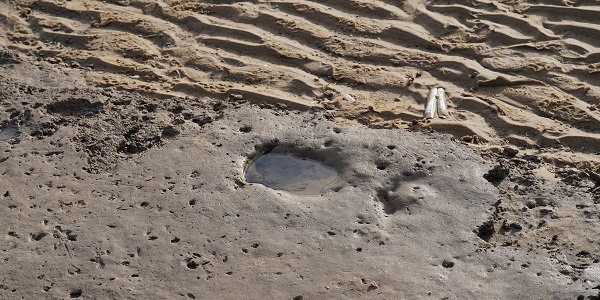Formby Footprints
Posted on: 1 September 2020 by Dr Alison Burns with contributions from Dr Ardern Hulme-Beaman in 2020 posts

The footprints at Formby provide an intimate glimpse into the past. Scrutiny of them tells us so much about the activities of ancient coastal communities in the northwest of England. The footprints formed while this region was made up of muddy salt-marshes. These salt-marshes flourished on and off across a period extending some ~8000 years.
During their early formation, the salt-marshes would have been periodically submerged as relative sea levels changed. At others they would have been inundated by tidal and storm surges. However, during periods of sea-level regression and during the summer months an extensive area of salt-marsh formed around the eastern and southern fringes of the Irish Sea basin.
The continued occupation of this region during extensive change demonstrates that these early coastal communities were able to rapidly adapt to these changes and would have been able to cope in this dynamic environment. The changing nature of the terrain would have been a regular feature of their lives both along the edge of the coast and further inland. At Formby, Mesolithic people made use of small rises in the wetland landscape for encampments and lithic production. The Mesolithic encampment on the banks of the Lunt is an example of this. When moving towards the coast they would have followed streams such as the Alt out to the mudflats.
Today, the footprints along the coast are our evidence of these people’s daily activity. It is speculated that the intermixing of human and animal footprints, with humans never standing within animal footprints, may demonstrate the regard that humans had towards animals in this shared coastal environment. Regular monitoring of the beds as they are exposed due to erosion along the shore and a record of the distribution of the footprints, has enabled their presence throughout the existence of the salt-marshes to be highlighted. This record also shows the importance of the salt-marshes for those based along the coast, even though their activities appear to have changed over time.
During the Mesolithic period, the salt-marshes would have been an open landscape, offering good visibility for some distance. In contrast, the inland fen-carr, a landform characterised by pools of water and stands of trees, would have felt close and restricted with poor visibility. This openness of the salt-marshes would likely have been very attractive — drawing people to it as rough pathways formed over the mud. Animals such as red deer (the most prolific of the animal species found at Formby) appear to have gathered in great numbers on the mudflats — walking in the damp cool mud and maybe grazing on the young sedge and grasses at the boundary between the salt-marshes and fen-carr.
Other animals were also drawn to this environment including: aurochs, roe deer, wild boar, wolf/dog, lynx, crane, oystercatcher, and different types of sea-birds. Many of these species were hunted by humans and are confirmed by a set of antlers shorn from a stag and the jaw of an aurochs with cut marks. These discoveries are exceptionally rare though and are the only ones to be recovered over the last 50 years. It is possible that the drier edge of the mudflats were used to process larger animals that would have been difficult to carry inland and so such activity will only be revealed when those regions of the mudflats are exposed through erosion.
Over time the species present on the marshes reduced. During the Neolithic and later periods, human activity became dominant. The footprints tend to run towards or from the sea suggesting sea voyaging, fishing activities or foraging for seafoods. As the climate and environment changed, the mudflats were inundated by sand and the coastline gradually accreted moving further to the west. Dunes and dune-slack formed, enabling stands of alder and oak to grow over the former mudflats and their roots down through them, sealing them for millennia until once again the changing coastline has uncovered them.
Formby beach and its erosion represents the strange juxtaposition of archaeology more generally; the practice of archaeology is both preservation and destruction to reveal further knowledge. This is never more starkly demonstrated than in the context of coastal erosion that reveals previously unknown features of the human and ecological past on a scale an archaeologist would never dream of carrying out. It is therefore paramount that these features be recorded as they are revealed as you never know what you might miss!
Discover more
Study in the Department of Archaeology, Classics and Egyptology at the University of Liverpool
We understand that this is a worrying and uncertain time for everyone, and the wellbeing of our students is our highest priority.
The University is here to offer you support and guidance as you continue with your studies. Please check your University email account daily so that you can continue to access advice and support from your module tutors regarding the shift to online teaching and alternative assessments.
The School will communicate with you regularly in response to students’ key concerns. Information is also available on our Coronavirus advice and guidance pages.
However, if you are have a specific query that you are unable to find the answer to online, please contact either your Academic Advisor or the Student Support Centre at hlcenq@liverpool.ac.uk
Keywords: Dr Alison Burns, Formby, archaeology, excavation, research, liverpool, merseyside, hearth.